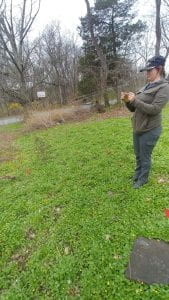Dowsing, also known as divining or witching, is a very old technique used for detecting
 buried objects of interest. Most commonly it used for detecting water, minerals, and graves but is also known to detecting anything under the sun including archaeological features and sites, coal, oil, treasure, and even missing people. It is widely accepted by those who use it and even by some archaeologists. Even with the wide acceptance in some fields, it is also widely contested because there is no scientific explanation behind it. Dowsers argue that humans or the dowsing rods are able to detect these changes and react accordingly. There are two main types of dowsing rods. The most common form used today are two thin metal wires in the shape of an ‘L’. The user holds the short end with the long side sticking straight out in front of the user. When the user crosses an object of interest, they cross. The second type is a Y shaped device usually make of willow or witch hazel that bends downward when detecting a buried object.
buried objects of interest. Most commonly it used for detecting water, minerals, and graves but is also known to detecting anything under the sun including archaeological features and sites, coal, oil, treasure, and even missing people. It is widely accepted by those who use it and even by some archaeologists. Even with the wide acceptance in some fields, it is also widely contested because there is no scientific explanation behind it. Dowsers argue that humans or the dowsing rods are able to detect these changes and react accordingly. There are two main types of dowsing rods. The most common form used today are two thin metal wires in the shape of an ‘L’. The user holds the short end with the long side sticking straight out in front of the user. When the user crosses an object of interest, they cross. The second type is a Y shaped device usually make of willow or witch hazel that bends downward when detecting a buried object.

One of the most common explanations for why dowsing works is based on magnetics. Some bacteria and animals are able to detect differences in the Earth’s magnetic field. This is the same principle which is used for magnetometer surveys. Other explanations including EPS, energy field variations, and even divine intervention. Studies of dowsing in the field have not yielded positive results for the practice. Some argue that the possible ‘misses’ were actually ‘hits’ because the dowser detected the location of a temporary structure or previously removed object that did not leave an archaeological footprint (see Dowsing and Church Archaeology by Bailey, Cambridge, and Briggs 1988). Other studies investigated the possible magnetic explanation and found that dowsers were unable to detect highly  magnetic pottery kilns that geophysical surveys and excavation were able to find (Aitken 1959).
magnetic pottery kilns that geophysical surveys and excavation were able to find (Aitken 1959).
I have participated in an archaeological excavation informed by dowsing. Like most investigations involving dowsing we were trying to determine if there were graves in a particular area. Our team member who conducted the dowsing allowed me to try. In accordance with Orser and Fagan’s 1977 review of dowsing only 30% of women are success at the technique. I am not part of that 30%. My male teammate walked around the flags he had previously places and the diving rods moved wildly. When they were passed to me, they barely moved. I had to stand within the flagged area for quite awhile before they crossed. Some argue this is because the rods move in accordance with ideomotor movement or small unconscious movement usually in response to outside stimulus such as walking and concentrating. When concentrating, people tend to lean forward and walk slower which could cause the rods to cross. When I dowsed, I tried to stay as still as possible which might explain my lack of sensitivity. We excavated the flagged areas and did not find any graves. Although one of the locations had a visible rock rubble pile on the surface and, in excavating, we discovered a dump site with some interesting trash. I was able to fit several plates, glass bottles, and a teapot back together. Even though we did not find the graves, the items in the trash pile were quite a lot of fun to research.
Sources:
Grave Dowsing Reconsidered by William Whittaker
Dowsing and Archaeology by Martijn Van Leusen 1998
Following IUP Anthropology on Facebook, Twitter, and Instagram
